First of all, my apologies to Mr. Izbicki, author of The Naked Heroine (see recommended reading below). I racked my brain trying to come up with a catchy title for this blog and I always returned to the title of his 1963 book, The Naked Heroine. It’s sort of like one of my more popular blogs, Cyndi Lauper and the Naked Princess. (Click here to read the blog.) As you all know, sex sells.
One of my prior blogs was about Josephine Baker (An African American in Pre-WWII Paris, click here to read). Josephine was an entertainer and stripper in Paris during the interwar period (the years between the two World Wars) and she became an international celebrity in those twenty years. During the German occupation of France, Josephine worked for the French Resistance collecting sensitive Nazi information from the German officers with whom she hobnobbed. Today, you will meet a young lady like Josephine but who structured her career in somewhat the reverse order. Lydia was first a French résistant and then after the war, spent the rest of her life taking off her clothes at the Folies Bergère and other popular clubs around Europe.
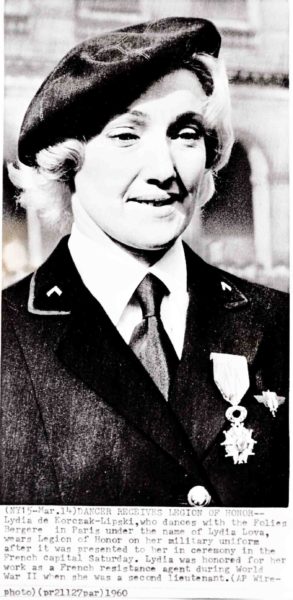
Besides being strippers and résistants, Lydia and Josephine shared one other attribute: they were both highly decorated French war heroines.
Did You Know?
Did you know there is an underground museum located on the Île de la Cité, the island in the middle of the Seine River? I’ll bet most of you have never been there let alone even know it exists. It’s one of those Paris attractions like the Arénes de Lutèce (the Roman amphitheater)⏤places few tourists visit. The entrance to the Crypte archéologique de l’île de la Cité, or Archeological Crypt is non-descript and easily missed. Located in the Place du Parvis Notre-Dame (the large square in front of Notre Dame Cathedral), you enter by walking down a flight of stairs. Visitors will see vestiges of Paris from the Gallo-Roman period to the nineteenth century when Napoléon III and Baron Haussmann rebuilt the island. From the Roman days, a section of the ancient port of Lutèce quay wall exists while the heating system from a Roman public bath has been preserved. The island was fortified in 308 A.D. and portions of the perimeter wall remain (you can see the outline of the wall’s path on Rue de la Colombe). Foundations and basements of buildings from the Middle Ages are visible. So, if you are a visitor to Paris and think you’ve seen everything, I suggest you visit the crypt. It’s like I’m fond of saying, “The largest museum in the world is twelve feet beneath the streets of Paris.” Well, that is until I visited Egypt last year. Now, Paris is second.
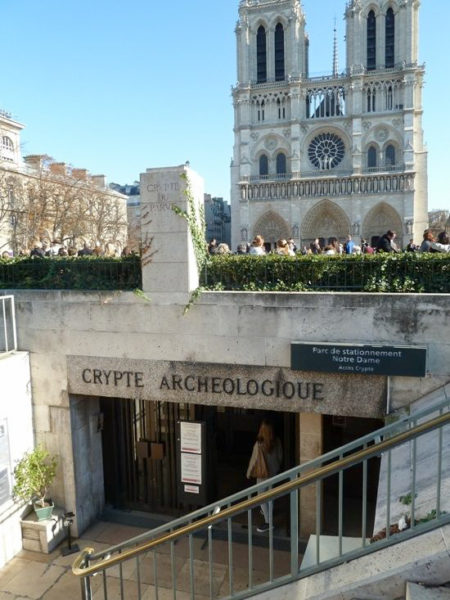

Lydia Lova de Korczak Lipski
Lydia Lova de Korczak Lipski (1925−1966) was born into a Polish aristocratic family in Warsaw. Her father, Count Wladimir de Korczak Lipski, was a direct descendant of Hungarian royalty. Wladimir fought with the British during World War I and after the war, he was employed by the British Secret Service. In 1932, Lydia and her family moved from Warsaw to France. After settling in Paris, her brother, Gerald, was born. Shortly afterward, Mrs. Lipski took Gerald back to Poland where she felt they would be safer from the impending threat of Hitler and the Germans. Lydia and her father remained in Paris and on 1 September 1939, the German army invaded Poland and World War II began. Lydia never saw her mother or brother again.
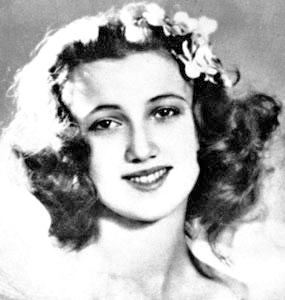
Interallié Network
One of the first organized resistance networks in France was the réseau Interallié. A Polish military officer, Roman Czerniawski (1910−1985), created the network on 18 November 1940 and began to provide London and MI6 with intelligence reports from occupied France. Czerniawski (nom de guerre: Armand) soon had a right-hand assistant: Mathilde Carré (nom de guerre: Victoire). Carré was also known as La Chatte, or The Cat. (Click here to read the blog, La Chatte.) Within twelve months, Carré became known as a traitor.
Czerniawski personally recruited Wladimir (nom de guerre: Observateur) and Lydia (nom de guerre: Cipinka) to work for Interallié. Father and daughter worked as a team and they were responsible for spying on industrial targets in the Paris area. They also collected details of German troop movements, positions of anti-aircraft armaments, and anything else Czerniawski asked them to do. Lydia had a passion for dancing, and she was good. Lydia was also very good at technical drawing and she copied blueprints of factories and German military installations.
Arrest and Imprisonment
Interallié was betrayed by Carré in November 1941 after being arrested along with Czerniawski. Within 24-hours of her arrest by the Gestapo, Carré agreed to become a double agent. Over the next month or so, Carré betrayed hundreds of Interallié agents including Lydia and her father. On 22 November 1941, Carré led the Gestapo to the Montmartre apartment where the de Lipski’s lived. They were arrested and sixteen-year-old Lydia spent eighteen months in the prisons of La Santé and Fresnes, often in solitary confinement. She was subjected to interrogation and torture by the Gestapo. Her father was able to smuggle notes to her where he would try and cheer her up by writing, “Do not forget that you have great talents, and that one day you can have a beautiful and happy life.” In July 1943, Lydia was deported to KZ Ravensbrück (prisoner no. 21690), a concentration camp for women. Her father was deported to KZ Mauthausen. Both of them were considered “Nacht und Nebel” prisoners and the only escape was through death. (Click here to read the blog, Night and Fog.)
KZ Ravensbrück
While imprisoned at Ravensbrück, Lydia was used for medical experimentation by the SS doctors. Polish women were specifically chosen for experiments on finding treatments for battle wounds. These women became known as the “Rabbits of Ravensbrück.” (Click here to read the blog The Rabbits of Ravensbrück) There were eighty-four “Rabbits”⏤ five died immediately from their infections, six were executed after surgery, and sixty-three miraculously survived (albeit with life-long disabilities including being crippled and in chronic pain). A prisoner would have their leg cut open (usually without anesthesia) and foreign objects would be introduced into the wound. These included wood, rusty nails, glass slivers, dirt, or just about anything a soldier might be exposed to on the battlefield. Then the medical “volunteer” would be treated with various drugs to see which drug produced the best results.
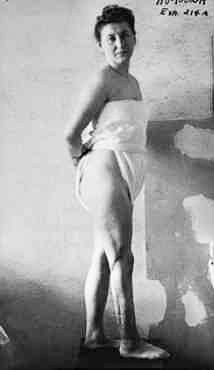
The SS doctor leading the surgical experiments was Dr. Karl Gebhardt (1897−1948; executed). Prior to his assignment at Ravensbrück, Gebhardt performed typhus experiments on prisoners at KZ Buchenwald. His specialty at Ravensbrück was maiming and crippling inmates before treating them with various drugs. He had bones broken or shattered and then introduced infectious germs. Gebhardt had limbs amputated in abnormal places and the victim was usually killed on the operating table at the end of the procedure. One of Gebhardt’s victims was Lydia de Korczak. She was called into his office and given an injection. Lydia asked the doctor what it was that he was injecting into her. Gebhardt told her not to worry. She would have to wait twenty to twenty-five years to find out the effects of the serum.
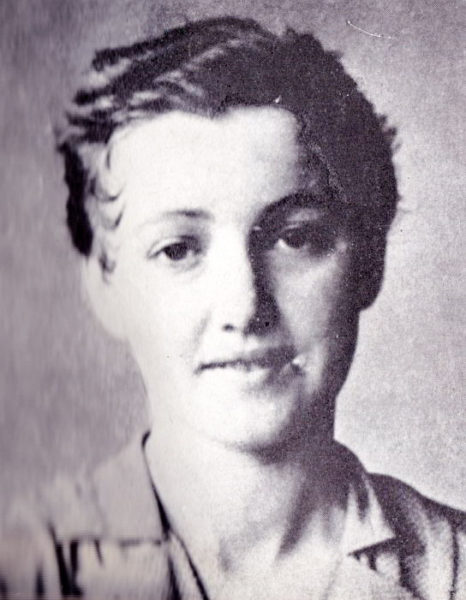
As the war was drawing to a close and the Nazis knew they would lose the war, attempts were made by senior Nazi officials to either cut a separate conditional surrender deal with the Allies or perform “humanitarian” acts in an effort to ensure favorable treatment after the war. Heinrich Himmler approved partial evacuations of the concentration camps. It was called the “White Bus Evacuations.” (Click here to read the blog, The White Buses.) Buses were painted white with giant red crosses on the roof and sides. The evacuations began on 15 March 1945 at KZ Sachsenhausen followed by KZ Dachau, Mauthausen and other concentration camps. Between March and May 1945, fifteen thousand inmates were released. The majority of them were Polish and French. When the buses got to Ravensbrück in April, Lydia was one of the 7,500 women waiting to board a bus to freedom in Denmark.
Remarkably, Wladimir survived his ordeal at Mauthausen and its infamous quarry. Lydia was reunited with her father at a convalescent home in Switzerland. She had turned twenty-one only a few months earlier.
Roman Czerniawski survived the war. He became a double agent for the Germans but tricked them into sending him to London to spy. However, immediately after landing in England, he turned himself into British Secret Service (MI5) and Special Operations Executive (SOE). Czerniawski became one of the agents responsible for convincing Hitler and the Nazis that the Allied invasion would take place at Pas de Calais. (Click here to read the blog, The Double Cross System.)
The Folies Bergère
Lydia gained back her strength and began to contemplate what she was going to do. She had a son, Patrick, and decided to make a career out of dancing. By 1950, Lydia was dancing at the Folies Bergère and soon, she became its featured star. I am sure that many people felt stripping was undignified for a résistant. Her professional name was Lydia Lova and she didn’t care what anyone thought about her chosen profession.
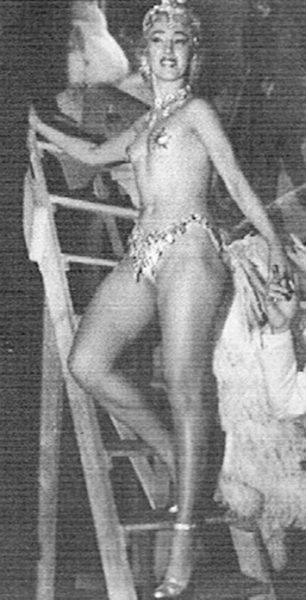
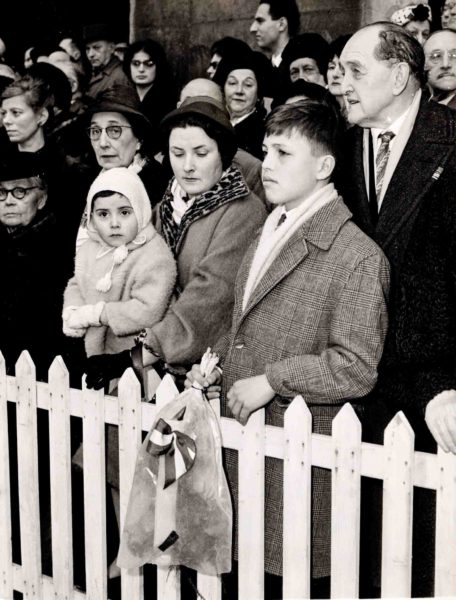
John Izbicki, correspondant for the Daily Telegraph, found out about Lydia’s background and persuaded her to be interviewed for his new book, The Naked Heroine. After the book was published in 1963, Lydia was invited to perform in London at the popular club, Casino de Paris London. She obtained a three-week release from the Folies Bergère. It was the first time she performed in a solo role and her act was a smash hit in England.
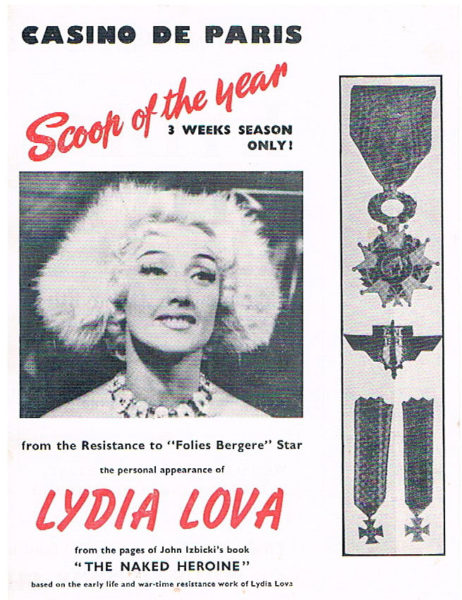
See if you can pick out Lydia in this video of the Folies Bergère production, “Paris Bohème” (Henri Decoin−1956). Her normal place in the chorus line was third from the left. Click here to watch the video.
The Awards
Like most résistants, Lydia did not want to talk about her wartime experiences. She preferred to look forward and not backward. Like Josephine Baker, Lydia was proud of her war efforts, but she did not want any of that to intersect with her dancing. However, by 1960, France honored Lydia by awarding her the Chevalier légion d’honneur, or Legion of Honor. It is the highest French order for military and civil merits. Chevalier, or Knight is the award’s highest rank. This medal followed a string of other awards including the Croix de guerre, or Cross of War.
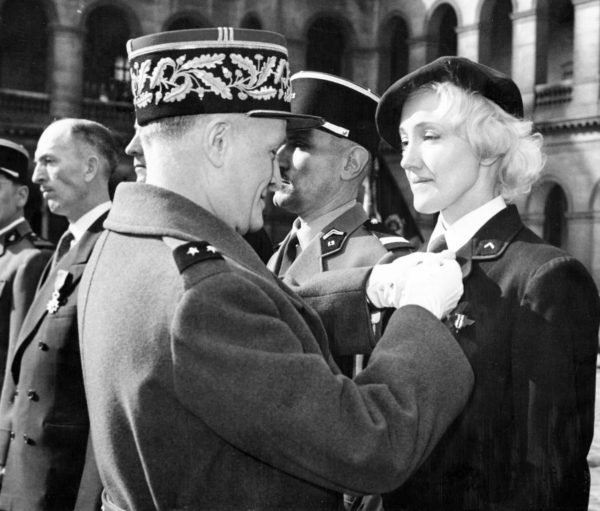
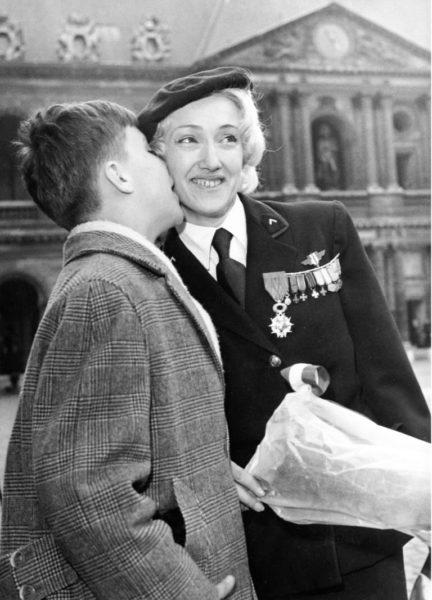
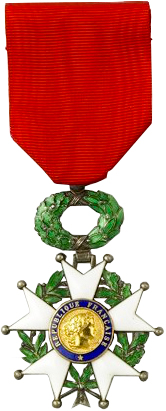
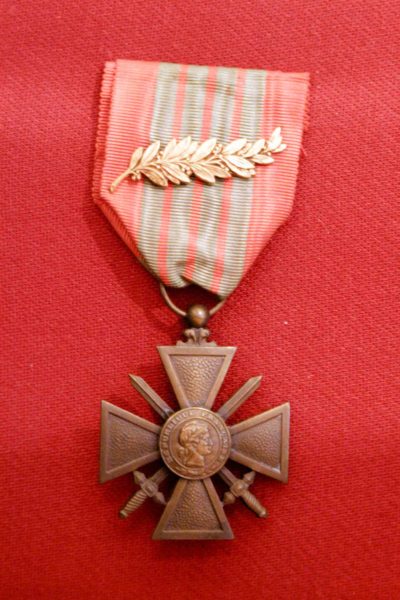
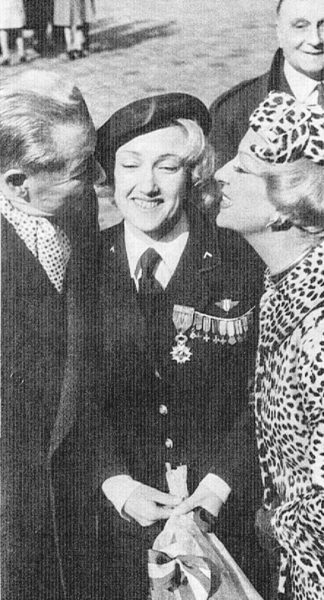
Lydia’s Last Dance
Lydia’s death on 6 February 1966 at the age of forty-one came as a complete surprise to everyone. Twenty-two years after being injected by the Nazis, Lydia died mysteriously.
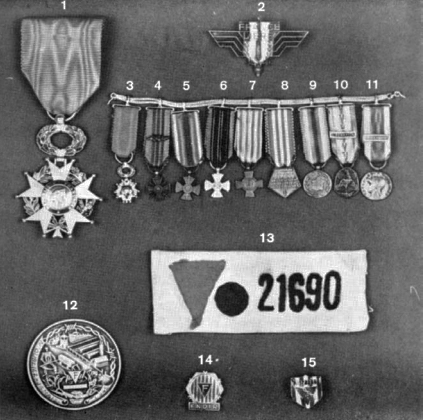
✭ ✭ ★ Learn More About the Naked Heroine ✭ ★ ★
Garby-Czerniawski, Roman. The Big Network. London: George Ronald, 1961.
Izbicki, John. The Naked Heroine: From the French Resistance to the Folies Bergère. London: Umbria Press, 2014. Original publisher: London: Neville Spearman Ltd., 1963.
Tremain, David. Double Agent Victoire: Mathilde Carré and the Interallié Network. Gloucestershire: The History Press, 2018.
Disclaimer:
There may be a chance that after we publish this particular blog, the video links associated with the blog are no longer accessible. We have no control over this. Many times, whoever posts the video has done so without the consent of the video’s owner. In some cases, it is likely that the content is deemed unsuitable by YouTube. We apologize if you have tried to access the link and you don’t get the expected results.
What’s New With Sandy and Stew?
Thank goodness 2020 is behind us. Let’s keep our fingers crossed that the new year will not be a reboot of the prior year. Although our two international trips in the first half of the year have been canceled, Sandy and I are looking forward to going to the UK and Paris in September. That is, if the borders are open to us. I have a feeling that airlines, cruise lines, or countries will not allow any of us to travel unless we have the vaccine, and it is recorded on our little yellow vaccination cards.
Sorry about missing the scheduled publication date for our blog, The Auschwitz Portraitist. It is the first and only time in eight years that our web site crashed. I’d like to be able to say we are such a high-profile site that the Russians or Chinese hacked into us, but I guess the United States Department of Defense is a much higher priority for hackers. It was actually a problem at Hostgator.
We are days away from sending our completed manuscript and images to Roy, our talented book designer. I’m really excited about this new book. At this point, I’m now working on volume two of Where Did They Put the Gestapo Headquarters?
Thank you to all of you who subscribe to our bi-weekly blogs. It seems there isn’t a day that goes by where we don’t increase our readership. Please let your history buff friends and family members know about our blogs.
Someone Is Commenting On Our Blogs
I’d like to thank Matthew G. for contacting us regarding our prior blog, I Was Looking Forward to a Quiet Old Age. Matthew is an award-winning author of non-fiction books. He is currently researching for his next book on Etta Shiber and Kate (“Kitty”) Bonnefous. I mentioned to him that very little has been written about these two resistance fighters other than Etta’s book. When I wrote the original blog in 2018, I could not find any answers as to what happened to Kate after her arrest by the Gestapo. I assumed she died at the hands of the Nazis. I told Matthew that Kate’s grandson contacted me several months ago to confirm his “Granny” had indeed survived the war along with her son. Unfortunately, Kate never told anyone about her wartime experiences. I wish Matthew all the best in his efforts to tell the story of these two brave women.
If there is a topic you’d like to see a blog written about, please don’t hesitate to contact me. I love hearing from you so keep those comments coming.
Why Would You Want to Buy Our Walking Through History Books?
Simple.
You like to travel and experience history and historical events. You like to see original buildings that had a significant impact on the people and events of the history you’re engaged with. You want to know the stories behind the brick and mortar in front of you.
The walking tour books are meticulously researched so you can go directly to those sites and learn about the building’s history as well as an introduction to some of the more interesting people associated with it.
We Need Your Help
Please tell your friends about our blog site and encourage them to visit and subscribe. Sandy and I are trying to increase our audience and we need your help through your friends and social media followers.
Thank You
Sandy and I appreciate you visiting with us. We have some exciting things on the horizon, and we’ll keep you updated as we go along.
Share This:
Follow Stew:
Find Stew’s books on Amazon and iBooks.
Please note that we do not and will not take compensation from individuals or companies mentioned or promoted in the blogs.
 Walks Through History
Walks Through History
Copyright © 2021 Stew Ross


Hello,
I read your article about Lydia very carefully and it reminds me of a lot of memories.
My name is Jean Wladimir and Count De Lipski was my godfather. I spent part of my childhood with him and his wife, my godmother Marthe. Your article has some grey areas and I think we could exchange about it if you’re interested by.
Best regards
Hi Jean; It’s wonderful that you contacted us about the blog. I’m not surprised you mention there are some “grey areas” in the story. Other than the book I mention in the blog, there wasn’t a lot of information available. Without the benefit of multiple resources, it’s tough to separate fact from fiction. So, I am looking forward to beginning a discussion with you and learning what needs to be changed. I will certainly update the blog after you and I have had the chance to talk. Again, thank you for the comments. STEW
Hi Stew ,
Cipinka was a friend of my mother’s,(Giga Bednarska ,Ravensbruck 7453).
If the above Jean Wladimir shared clarifications with you , could I please somehow be availed of them ?
I would like to add anything I can to my mom’s memoir and to my copy of the book by Izbicki , which I have owned most of my life .
Danek
Hi Danek; I will attempt to contact Jean and ask if he would like me to introduce you. I think the two of you might have a very interesting discussion considering the close connection you each share with Lydia (“Cipinka”). Thank you for reaching out to us. STEW
this is the first time that I am meeting a person who has heard of Cipinka